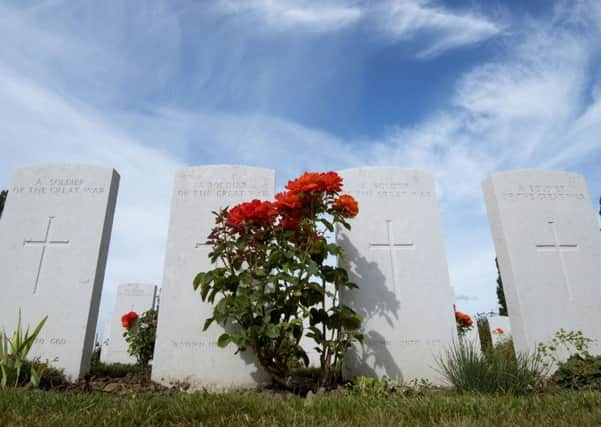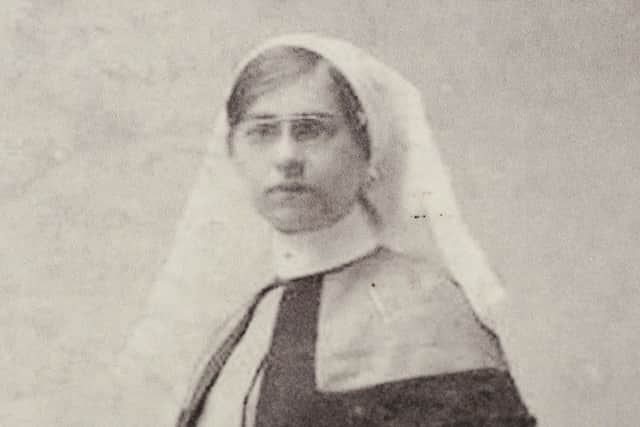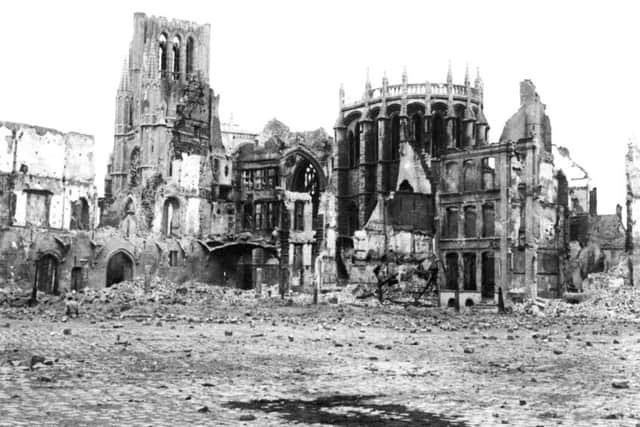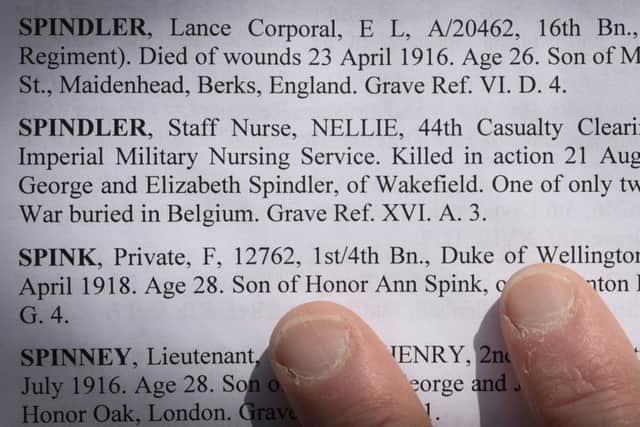Armistice 100: Visiting the final resting place of Wakefield nurse Nellie Spindler


For a remarkable woman like Wakefield’s Nellie Spindler it only seems truly fitting that her final resting place would befit her bravery.
Hers is no ordinary story.
The courageous nurse was only one of two women to have their deaths recorded as being killed in action on a form used to record the death of officers during the First World War.


Advertisement
Hide AdAdvertisement
Hide AdShe arrived in France on May 23, 1917 before being deployed to Belgium where soldiers would face horrific conditions in one of the bloodiest battles of the war. The field hospital in Passchendaele where Nellie was stationed, serving as a specialist in abdominal wounds, lay close to the field of battle at Flanders.
The 26-year-old died in the arms of her colleague, who also hailed from her home city, after the military hospital in Brandhoek was shelled.
She was given the honour of a full military funeral as the Last Post was played by her graveside.
And her grave takes pride of place among more than 10,000 men at Lijssenthoek Military Cemetery.


For Nellie is the only woman in this cemetery.
Advertisement
Hide AdAdvertisement
Hide AdBut what is clear from the small crosses left by her graveside is that her bravery will be remembered for many, many years to come.
It was quite striking to see her grave after reading so many stories about her life over the years in the Yorkshire Evening Post.
Who knows just how many people came to visit her on the same day that we did.


And who knows how many more people will come and continue to visit her as the years roll by.
Advertisement
Hide AdAdvertisement
Hide AdOur tour guide reminded us that there is no such thing as a battlefield tourist to the people of Belgium.
You are simply a pilgrim trying to piece your very own history together.
And from the scores of cemeteries, monuments and memorials the human toll of war becomes all but too apparent.
The glistening Portland stone graves sparkle as the sun catches them stood in uniformed rows.
Advertisement
Hide AdAdvertisement
Hide AdEach headstone contains the national emblem or regimental badge as well as the details of each casualty. Families could also choose a more personal dedication should they wish.
They remain to this day a lasting legacy of the Imperial War Graves Commission – more recently known as the Commonwealth War Graves Commission.
Its members were faced with the enormous task of recording the country’s war dead.
It is believed by 1918, some 587,000 graves had been identified and a further 559,000 casualties were registered as having no known grave.
Advertisement
Hide AdAdvertisement
Hide AdArchitects were appointed and the task of creating cemeteries and memorials started in earnest.
From small cemeteries to larger memorial sites the final resting place of soldiers are scattered across the Belgian landscape.
Tucked away on a small residential side street in Voormezele is a quite unassuming graveyard with scores of headstones lined side by side.
But one grave in particular stands out from the rest of the crisp white headstones.
Advertisement
Hide AdAdvertisement
Hide AdThe small Peter Pan trinket could be a giveaway to the secrets of who its final resting place belongs to.
It is the grave of George Llewelyn Davies. The 21-year-old, who was the inspiration for JM Barrie’s characters of Peter Pan and The Lost Boys, served in the trenches in Flanders.
He was killed in action in 1915.
George, who was adopted by the renowned author, really did become the boy who would never grow up.
This quiet corner of Belgium differs in stark contrast to the hustle and bustle of pilgrims descending on Tyne Cot.
Advertisement
Hide AdAdvertisement
Hide AdThe towering obelisk of Tyne Cot lurks over the landscape however, it’s not until you step foot into the site that you can comprehend the sheer number of gravestones in the site. The rows are almost enough to take your breath away.
It is the largest cemetery for Commonwealth forces in the world for any war and is named by the Northumberland Fusiliers.
The concrete shelters used by the German forces still stand in the site which played an important tactical role during the Battle of Passchendaele in 1917.
Yet among the rows of graves the one that struck me the most simply said: “A soldier of the Great war. King’s Own Yorkshire. LL. Known Unto God”.
Who did this final resting place belong to?
Advertisement
Hide AdAdvertisement
Hide AdAs we spent the day progressing along the Western Front it becomes apparent that it’s not just about mourning the dead.
There is also a strong sense of reconciliation with the past.
Between the graves of British soldiers at Tyne Cot there stands two gravestones listing the four German soldiers – three of whom were unknown – killed in battle.
There is also the Langemark cemetery – one of only four First World War German cemeteries in the Flanders region.
Advertisement
Hide AdAdvertisement
Hide AdA mass grave of 24,917 servicemen awaits visitors at the entrance of the site – a stark comparison to other memorials we visited throughout the day.
Rather than tall white headstones aligned with military precision, the final resting place for these soldiers is a small marker in the ground for multiple casualties.
And between the oak trees is another mass grave for those who were moved from other battlefields across the Ypres salient. The casualties on both sides of the battle lines are stark.
Yet the sentiment remains – a wreath from a British school flutters with a simple message. We will remember.